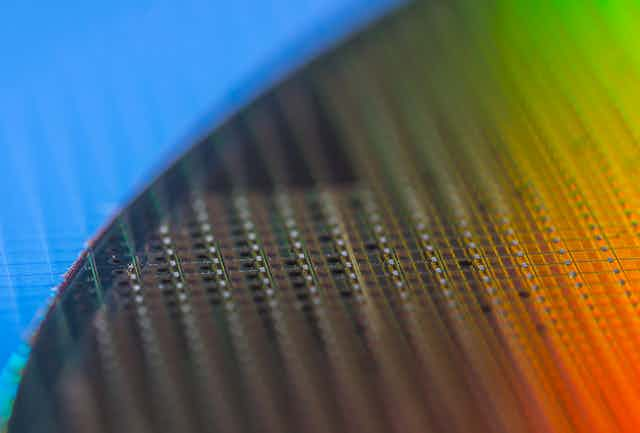Your television, computer, smartphone or any other electronic device wouldn’t work without being able to shuttle electric charges around their circuits.
Yet, as these devices gain in performance, with their individual components getting smaller and smaller – reaching the nanoscale – it becomes increasingly difficult to precisely channel these electric charges to where they’re needed.
In fact, at the nanoscale, some of these components behave in very strange ways, to the point where even a single atom can influence or disrupt the flow of electrons. A better understanding and control of these nanoscale dynamics is therefore crucial to improve their function.
On the edge
Transistors are the basic building blocks of microchips, and are found in everything from computers, to smartphones and amplifiers. Their function fundamentally depends on how electrons flow near or at the interfaces between their metallic, insulating and semiconductor materials.
Transistors today can be as small as 10 nanometres wide, and they’re getting smaller. If you have a smartphone in your pocket, it most probably has more than a billion transistors within.
As this miniaturisation trend continues, the performance of electronic components is more and more influenced by what happens to electrons at the boundaries of materials, since the likelihood of an electron being close to an interface increases as size decreases.
This is like if you find yourself in a room, then the smaller the room, the higher the probability that you will be standing next to a wall.
A similar phenomenon also affects solar cells, which generate electricity when positive and negative charges are separated within a few nanometers at the boundary between electron donating and electron accepting materials.
Light-emitting diodes can work the other way around: they can generate light when positive and negative charges recombine at these boundaries.
Organic molecules – similar to those responsible for photosynthesis in bio-organisms – with semiconducting properties are very promising materials for devices, such as transistors, solar cells and light-emitting diodes.
They are cost-effective, light, flexible and versatile. Their electronic properties are tuneable, and their production consumes less energy than that of silicon.
Around the islands
We recently investigated two-dimensional nano-clusters – or “nano-islands” – of different sizes and shapes, composed of organic semiconducting molecules on a thin insulator to see how electronic properties varied at different locations on them.
We used a scanning tunnelling microscope to determine the atomic-scale structure and electronic properties of the organic nano-islands.
The measurement of these currents allows us to create an image of the surface of the material to understand where atoms and electrons are located. These measurements were so sensitive that we had to perform them at a laboratory with extremely low vibrations at the University of British Columbia, in Canada.
Our experiments showed that the electrons of the molecules at the edge of the nano-islands behaved dramatically differently than those in the middle. Importantly, these differences in electronic behaviour depended strongly on subtle variations of position and orientation of the molecules nearby.
We found that when an electron is removed at a specific location in the centre of a nano-island, the electrons of the surrounding material react, moving towards the positive charge created by the electron removal.
Similarly, if an electron was added, the surrounding electrons moved away from the negative charge created by the electron addition. This collective motion of electrons polarises the surrounding environment and stabilises the created charge: the charge gets screened.
In contrast, when an electron is removed or added at the boundary of the nano-island – where transfer of electrons becomes important for technological applications – the created charge is screened a lot less efficiently.
Think of a crowded party where suddenly someone leaves the centre of the room, creating an empty space. The people dancing around will gradually occupy this spot a lot quicker than if the person had left the edge of the room.
This is not entirely surprising. What is surprising, though, is the magnitude of the effect. Our findings show that the energies involved in this are very large.

Tuning at the nanoscale
Our work suggests a problem for the design of efficient nanoelectronic devices. Not only do subtle features of the nanoscale structure of components induce severe electronic effects at their interfaces, but also the influence of these effects becomes more important as the size of components shrink.
So it is crucial to control the arrangement of atoms and molecules at the interfaces between these components, and do this with incredible precision, in order to design new technologies with optimal efficiency and functionality.
Our findings open the door to new engineering approaches where the electronic properties of nano-devices can be tuned by small and precise variations of their atomic-scale structure.
This could be achieved by moving atoms and molecules on a surface of a material in a controlled manner. Another possible way is to use supramolecular self-assembly, where atoms and molecules interact and automatically arrange themselves in desirable patterns at the nanoscale.
So while the effects we have discovered present a challenge for the future of nanoelectronic devices, they also present a terrific opportunity to develop faster and more efficient communication, information and electronic technologies.

